MORE AUTUMNAL NEATENING
An Upbeat Closing
I don’t know about you all, but I have a great urge to tidy up my garden this time of year. Partly it’s because doing so leaves one less thing to do in spring and partly because, as Charles Dudley Warner wrote in My Summer in the Garden in 1889, “the closing scenes need not be funereal.” All this tidying up is usually quite enjoyable.
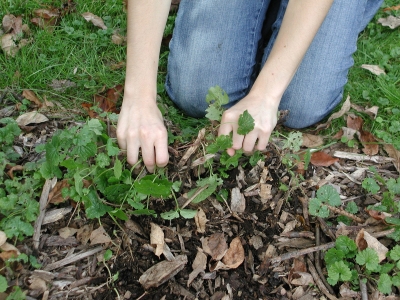
Moist soil – and not too, too many weeds – make weeding fun. Creeping Charlie (also know as gill-over-the-ground) has sneaked into some flower beds. Its creeping stems are not yet well-rooted so one tug with a gloved hand and a bunch of escaping stems slithers back from its travels forward from beneath and among flower plants and shrubs. What remains are occasional tufts of grassy plants, especially crabgrass, easily wrenched out of the ground or coaxed out with my Hori-Hori garden knife.
This tidying is intimate work: me, the soil, weeds, and garden plants at close range. While I’m down there on hands and knees, I’ll also cut back some old stalks of perennial flowers. When everything is cleaned up, I’m going to spread a blanket of chipped wood (free, a “waste” product from arborists) over all bare ground.
The one thing not to do this time of year, as far as tidying up, is pruning. Better to prune after the coldest part of winter is over and closer to when plants can heal wounds.
A Real Crocus, Now
A few weeks ago, I, along with anyone visiting my garden, was wowed by autumn crocuses then in bloom. As I pointed out, they weren’t not true crocuses (they were Colchicum species), they just acted like crocuses – on steroids. Then, a couple of weeks later, I noticed that my true autumn crocuses (that is, the ones that are true Crocus species) were in bloom.
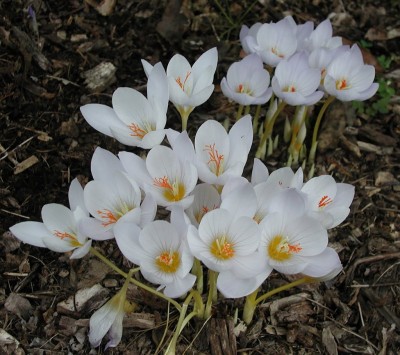
And I did really have to stop and notice them after that most flamboyant show of fake autumn crocuses. These true crocuses (crocii?) are dainty plants, just like spring crocuses, and their colors are subdued: some are pale violet and some are white. In contrast to the fake autumn crocuses, which multiplied like gangbusters, the real autumn crocuses look about dense as when I planted them. Both kinds of crocuses wait until spring to show their leaves.
It’s fortunate that the part of my garden that’s home to autumn crocuses, real and fake — the mulched area beneath the dwarf apple trees — is free of weeds. Otherwise, the real autumn crocuses, being so dainty and lacking a supporting role of leaves, would be swallowed up, visually or for real.
Weed? Perhaps.
Back to weeds . . . I’m trying to see the positive side of all that creeping Charlie I’ve been pulling. Bits of it that have insinuated themselves in amongst the bases of stems of woody shrubs, especially thorny ones like the Frau Dagmar Hastrup rose, are not that much fun to weed out. So what’s good about creeping Charlie?
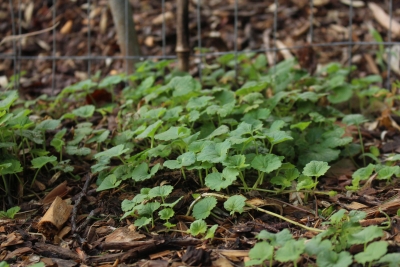
For one thing, with shiny, round leaves of a deep, forest green color, it’s not a bad looking weed. The flowers are an attractive, purple color although neither big nor prominent enough to make a statement. The otherwise excellent reference book Weeds of the Northeast (Cornell University Press) erroneously states that “the foliage emits a strong mint-like odor when bruised.” That would be nice except that I’ve never noticed that odor and didn’t even when I just ran outside to crush some leaves check up on this statement.
Creeping Charlie grows well in sun or shade, so well that when I worked in agricultural research for Cornell University, I considered the plant as a possible groundcover to replace the relatively sterile herbicide strips in apple orchards. It grows as such beneath my dwarf pear trees.
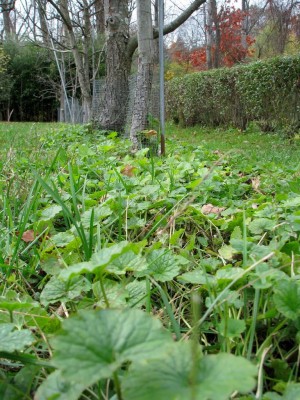
Creeping Charlie beneath my pear trees
The plant could even be a somewhat ornamental groundcover, making up for any lack of great beauty with its capability to rapid fill in an area and grow only a couple of inches high. You couldn’t ask much more from a plant – except to keep out of some of my flower beds.

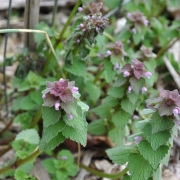

It’s reassuring to see that the dozens of garden and compost jobs I did throughout the fall will pay off in an easier start and better vegetable and flower gardens next season. Your newspaper columns introduced me to your skill and enthusiasm for gardening. Thanks, Lee, for all the help and instruction over the years.
You don’t smell the distinct mint odor when you pull creeping Charlie, and you can’t smell your Katsura tree? I hate to say it, but you may just be “olfactorily challenged”. I’m wondering if you could smell the fruity odor emanating from my Russian quince as it ripens. It almost knocks me over from 75 feet away! Oh well, we all have our individual strengths and weaknesses, and you have so many beautiful things to see and enjoy in your farmden!
I actually have a very sensitive nose. I’ll go out and smell it again tomorrow. Or maybe it ony has aroma in summer heat?
I feel your pain. Buttercup is my nemesis here in the Seattle. It also is pretty and grows well in sun or shade. What bothers me about it is when it decides it needs more sun it grows straight up. I’ll find its flowers towering over my hydrangea bushes if I don’t get it out from under them. It also likes to smother any wanted ground covers, including strawberries. Mixed with strawberries, it is somewhat hard to identify because it grows very similar and has leaves that look slightly like strawberry leaves. I wish I could find a solution but everything I see says they don’t like dry soil. Not easy to find dry soil in Seattle.
Yup, fall cleaning is many versions. I like to leave as much insect and bird feed as is possible…Alaska Southeast panhandle. Just depends on zone, predator, and weed pressure.
Do you put aged wood chips on the bare soil or are fresh ok? Other than lasting longer, what are the merits of using those rather than shredded leaves as mulch in perennial and annual beds? Thanks v much!
Fresh is okay and you’re right about the only benefit is longer lasting than leaves (or aged wood chips).